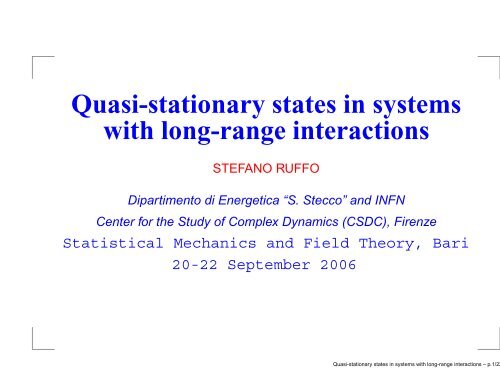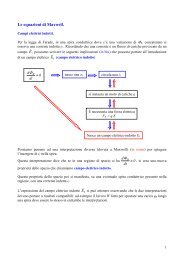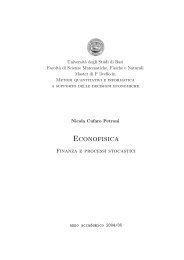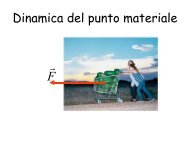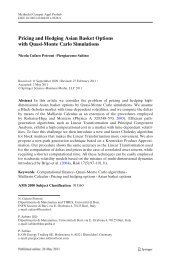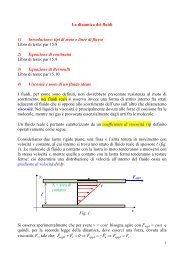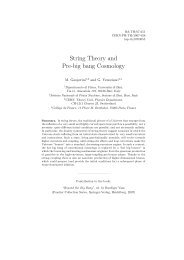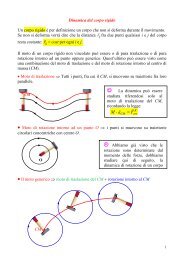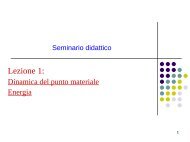Quasi-stationary states in systems with long-range interactions - Infn
Quasi-stationary states in systems with long-range interactions - Infn
Quasi-stationary states in systems with long-range interactions - Infn
You also want an ePaper? Increase the reach of your titles
YUMPU automatically turns print PDFs into web optimized ePapers that Google loves.
<strong>Quasi</strong>-<strong>stationary</strong> <strong>states</strong> <strong>in</strong> <strong>systems</strong><strong>with</strong> <strong>long</strong>-<strong>range</strong> <strong>in</strong>teractionsSTEFANO RUFFODipartimento di Energetica “S. Stecco” and INFNCenter for the Study of Complex Dynamics (CSDC), FirenzeStatistical Mechanics and Field Theory, Bari20-22 September 2006<strong>Quasi</strong>-<strong>stationary</strong> <strong>states</strong> <strong>in</strong> <strong>systems</strong> <strong>with</strong> <strong>long</strong>-<strong>range</strong> <strong>in</strong>teractions – p.1/22
PlanHamiltonian Mean Field (HMF) model<strong>Quasi</strong>-<strong>stationary</strong> <strong>states</strong>Non equilibrium phase transitionLynden-Bell entropyMaximum entropy pr<strong>in</strong>cipleApplication to the free electron laser<strong>Quasi</strong>-<strong>stationary</strong> <strong>states</strong> <strong>in</strong> <strong>systems</strong> <strong>with</strong> <strong>long</strong>-<strong>range</strong> <strong>in</strong>teractions – p.2/22
HMF modelH XY =N∑i=1p 2 i2 + 12NN∑i,j=1(1 − cos(θ i − θ j ))Inspired byGravitational and charged sheet modelsWave-particle <strong>in</strong>teractions<strong>Quasi</strong>-<strong>stationary</strong> <strong>states</strong> <strong>in</strong> <strong>systems</strong> <strong>with</strong> <strong>long</strong>-<strong>range</strong> <strong>in</strong>teractions – p.3/22
<strong>Quasi</strong>-<strong>stationary</strong> <strong>states</strong>Initial water-bag of (semi) width ∆θ 0 = π and height ∆p 0(which determ<strong>in</strong>es the energy U = H/N)Magnetization M = ( ∑ Ni=1 cos θ i/N, ∑ Ni=1 s<strong>in</strong> θ i/N)0.3570.30.25(a)6(b)M(t)0.20.15b(N)540.10.0530−1 0 1 2 3 4 5 6 7 8log 10tLEFT: U = 0.69, from left to rightN = 10 2 , 10 3 , 2 × 10 3 , 5 × 10 3 , 10 4 , 2 × 10 421 2 3 4 5logNRIGHT: Power law <strong>in</strong>crease of the lifetime, exponent 1.7<strong>Quasi</strong>-<strong>stationary</strong> <strong>states</strong> <strong>in</strong> <strong>systems</strong> <strong>with</strong> <strong>long</strong>-<strong>range</strong> <strong>in</strong>teractions – p.4/22
Phase transition0.70.60.5U=0.50U=0.540.7M(t)0.40.30.2U=0.620.100 5 10 15 20 25 30 35 40 45 50 55LEFT: N = 10 3tU=0.58hfp0.60.50.40.30.20.1(a)00.5 0.55 0.6 0.65 0.7 0.75 0.8URIGHT: First peak height as a function of U = H/N for<strong>in</strong>creas<strong>in</strong>g values of N (10 2 , 10 3 , 10 4 , 10 5 )<strong>Quasi</strong>-<strong>stationary</strong> <strong>states</strong> <strong>in</strong> <strong>systems</strong> <strong>with</strong> <strong>long</strong>-<strong>range</strong> <strong>in</strong>teractions – p.5/22
HMF Vlasov equation∂f∂t + p∂f ∂θ − dVdθ∂f∂p = 0 ,V (θ)[f] = 1 − M x [f] cos(θ) − M y [f] s<strong>in</strong>(θ) ,∫M x [f] = f(θ,p,t) cos θdθdp ,∫M y [f] = f(θ,p,t) s<strong>in</strong> θdθdp .Specific energye[f] = ∫ (p 2 /2)f(θ,p,t)dθdp + 1/2 − (M 2 x + M 2 y)/2 andmomentum P[f] = ∫ pf(θ,p,t)dθdp are conserved.<strong>Quasi</strong>-<strong>stationary</strong> <strong>states</strong> <strong>in</strong> <strong>systems</strong> <strong>with</strong> <strong>long</strong>-<strong>range</strong> <strong>in</strong>teractions – p.6/22
Vlasov simulations<strong>Quasi</strong>-<strong>stationary</strong> <strong>states</strong> <strong>in</strong> <strong>systems</strong> <strong>with</strong> <strong>long</strong>-<strong>range</strong> <strong>in</strong>teractions – p.7/22
Lynden-Bell entropyAssume that the <strong>in</strong>itial distribution f(θ,p, 0) takes only twovalues (0,f 0 ) (“water bag"). Time evolution can only modifythe shape of the boundary of the “water-bag", conserv<strong>in</strong>gthe area <strong>in</strong>side it. Hence, the distribution rema<strong>in</strong>s two-levelas time evolves. Coarse-gra<strong>in</strong><strong>in</strong>g amounts to perform alocal average of f <strong>in</strong>side a given cell, which gives ¯f. The“mix<strong>in</strong>g" entropy per particle associated <strong>with</strong> ¯f is(Lynden-Bell, 1967)∫s( ¯f) = −dpdθ[ ¯ff 0ln ¯ff 0+(1 − ¯f ) (ln 1 − ¯f )].f 0 f 0Lynden-Bell guesses that the <strong>in</strong>itial evolution (“violentrelaxation") is characterized by a maximization of this“fermionic" entropy <strong>with</strong> given constra<strong>in</strong>ts (e.g. energy,momentum, ...).<strong>Quasi</strong>-<strong>stationary</strong> <strong>states</strong> <strong>in</strong> <strong>systems</strong> <strong>with</strong> <strong>long</strong>-<strong>range</strong> <strong>in</strong>teractions – p.8/22
Derivation of Lynden-Bell entropyFermionic pr<strong>in</strong>ciple: If the <strong>in</strong>itial s<strong>in</strong>gle-particle distribution is two-level (0, f 0 ), it rema<strong>in</strong>s twolevel dur<strong>in</strong>g time evolution (Liouville theorem).Other <strong>in</strong>variants (Casimirs) of the Vlasov equation exist.Divide the bounded phase space <strong>in</strong>to a f<strong>in</strong>ite number of macrocells. Each macrocell conta<strong>in</strong>sν microcells of size h. Let n i be the number of microcells occupied by the level f 0 <strong>in</strong> the i thmacrocell and N the total number of occupied microcells.Then the number of micro<strong>states</strong> compatible <strong>with</strong> the macrostate n i isW({ ¯f}) = W({n i }) = QN!i n i! × Y iν!(ν − n i )! ,<strong>with</strong> ¯f the coarse-gra<strong>in</strong>ed distribution. The mix<strong>in</strong>g (Lynden-Bell) entropy isS LB = ln[W({ ¯f})].<strong>Quasi</strong>-<strong>stationary</strong> <strong>states</strong> <strong>in</strong> <strong>systems</strong> <strong>with</strong> <strong>long</strong>-<strong>range</strong> <strong>in</strong>teractions – p.9/22
Maximal Lynden-Bell entropy <strong>states</strong>¯f(θ, p) = f 0e −β(p2 /2−M y [ ¯f] s<strong>in</strong> θ−M x [ ¯f] cos θ)−λp−µ1 + e −β(p2 /2−M y [ ¯f] s<strong>in</strong> θ−M x [ ¯f] cos θ)−λp−µ .f 0f 0f 0f 0Zx √βZx2β 3/2 Zx √βZx √βdθe βM·m F 0“xe βM·m” = 1dθe βM·m F 2“xe βM·m” = e + M2 − 12dθ cos θe βM·m F 0“xe βM·m” = M xdθ s<strong>in</strong> θe βM·m F 0“xe βM·m” = M yM = (M x , M y ), m = (cos θ, s<strong>in</strong> θ).F 0 (y) = R exp(−v 2 /2)/(1 + y exp(−v 2 /2))dv,F 2 (y) = R v 2 exp(−v 2 /2)/(1 + y exp(−v 2 /2))dv.f 0 = 1/(4∆θ 0 ∆p 0 )<strong>Quasi</strong>-<strong>stationary</strong> <strong>states</strong> <strong>in</strong> <strong>systems</strong> <strong>with</strong> <strong>long</strong>-<strong>range</strong> <strong>in</strong>teractions – p.10/22
Velocity PDFs<strong>in</strong>gle particle distribution|M 0|=0.3|M 0|=0.50.10.1f(p)0.01-1.5 -1 -0.5 0 0.5 1 1.50.01-1.5 -1 -0.5 0 0.5 1 1.50.10.1|M 0|=0.70.01-1.5 -1 -0.5 0 0.5 1 1.50.01-1.5 -1 -0.5 0 0.5 1 1.5p|M 0|=0.9|M 0 | = s<strong>in</strong>(∆θ 0 )/∆θ 0Non Gaussian velocity distributions<strong>Quasi</strong>-<strong>stationary</strong> <strong>states</strong> <strong>in</strong> <strong>systems</strong> <strong>with</strong> <strong>long</strong>-<strong>range</strong> <strong>in</strong>teractions – p.11/22
Tricritical po<strong>in</strong>tU0,75 0,750,7 0,70 0,05 0,1 0,150,5850,580,65 0,650,610,6050,60,5950,590,6 0,61 ST order l<strong>in</strong>eU 2 ND order l<strong>in</strong>ec=7/12tricritical po<strong>in</strong>t0,55 0,550 0,2 0,4 0,6 0,8 1|M| 0<strong>Quasi</strong>-<strong>stationary</strong> <strong>states</strong> <strong>in</strong> <strong>systems</strong> <strong>with</strong> <strong>long</strong>-<strong>range</strong> <strong>in</strong>teractions – p.12/22
Features of the phase transition0,60,5a)|M 0 |=0.8|M 0 |=0.55b)|M 0 |=0.1|M 0 |=0.010,30,25f QSS(p)0,40,30,2|M| QSS0,20,150,10,10,050-1,5 -1 -0,5 0 0,5 1 1,5p00,6 0,7 0,8 0,9|M| 0<strong>Quasi</strong>-<strong>stationary</strong> <strong>states</strong> <strong>in</strong> <strong>systems</strong> <strong>with</strong> <strong>long</strong>-<strong>range</strong> <strong>in</strong>teractions – p.13/22
Addition of a short <strong>range</strong> contributionH =N∑i=1p 2 i2 + 12NN∑i,j=1[1 − cos (θ i − θ j )]−KN∑i=1cos (θ i+1 − θ i ) .LEFT: M(t) vs. t; K = 0.05, U = 0.71, N = 1024,...,32768RIGHT: <strong>in</strong>crease of the lifetime; K = 0, 0.0025, 0.05, 0.1<strong>Quasi</strong>-<strong>stationary</strong> <strong>states</strong> <strong>in</strong> <strong>systems</strong> <strong>with</strong> <strong>long</strong>-<strong>range</strong> <strong>in</strong>teractions – p.14/22
HMF core-halo structureRef<strong>in</strong>ements of maximum entropy methods should take <strong>in</strong>toaccount the "true" dynamics.<strong>Quasi</strong>-<strong>stationary</strong> <strong>states</strong> <strong>in</strong> <strong>systems</strong> <strong>with</strong> <strong>long</strong>-<strong>range</strong> <strong>in</strong>teractions – p.15/22
Free Electron LaseryColson-Bonifacio modelxzdθ jdzdp jdzdAdz= p j= −Ae iθ j− A ∗ e −iθ j= iδA + 1 NXje −iθ j<strong>Quasi</strong>-<strong>stationary</strong> <strong>states</strong> <strong>in</strong> <strong>systems</strong> <strong>with</strong> <strong>long</strong>-<strong>range</strong> <strong>in</strong>teractions – p.16/22
<strong>Quasi</strong>-<strong>stationary</strong> <strong>states</strong>0.8Laser <strong>in</strong>tensity (arb. units)0.60.40.2Laser <strong>in</strong>tensity0.60.51230.40 500 1000 1500 2000- z00 20 40 60 80 100 120 140 160 180 200N = 5000 (curve 1), N = 400 (curve 2), N = 100 (curve 3)On a first stage the system converges to a quasi-<strong>stationary</strong> state. Later it relaxes toBoltzmann-Gibbs equilibrium on a time O(N). The quasi-<strong>stationary</strong> state is a Vlasovequilibrium, sufficiently well described by Lynden-Bell’s Fermi-like distributions.-z<strong>Quasi</strong>-<strong>stationary</strong> <strong>states</strong> <strong>in</strong> <strong>systems</strong> <strong>with</strong> <strong>long</strong>-<strong>range</strong> <strong>in</strong>teractions – p.17/22
Vlasov equationIn the N → ∞ limit, the s<strong>in</strong>gle particle distribution functionf(θ,p,t) obeys a Vlasov equation.∂f∂z∂A x∂z∂A y∂¯z= −p ∂f∂θ + 2(A x cos θ − A y s<strong>in</strong> θ) ∂f∂p= −δA y + 1 ∫f cosθ dθdp ,2π= δA x − 1 ∫f s<strong>in</strong> θ dθdp .2π,<strong>with</strong> A = A x + iA y = √ I exp(−iϕ)<strong>Quasi</strong>-<strong>stationary</strong> <strong>states</strong> <strong>in</strong> <strong>systems</strong> <strong>with</strong> <strong>long</strong>-<strong>range</strong> <strong>in</strong>teractions – p.18/22
Vlasov equilibriaLynden-Bell entropy maximizationZS LB ( ¯f) = −dpdθ„ ¯fln ¯f „+ 1 − ¯f « „ln 1 − ¯f ««.f 0 f 0 f 0 f 0S LB (ε, σ) =Zmax [S LB ( ¯f)|H( ¯f, A x , A y ) = Nε;¯f,A x ,A ydθdp ¯f = 1; P( ¯f, A x , A y ) = σ].¯f = f 0Non-equilibrium field amplitudee −β(p2 /2+2A s<strong>in</strong> θ)−λp−µ1 + e −β(p2 /2+2A s<strong>in</strong> θ)−λp−µ .A =qA 2 x + A 2 y =ββδ − λZdpdθ s<strong>in</strong> θ ¯f(θ, p).<strong>Quasi</strong>-<strong>stationary</strong> <strong>states</strong> <strong>in</strong> <strong>systems</strong> <strong>with</strong> <strong>long</strong>-<strong>range</strong> <strong>in</strong>teractions – p.19/22
Results20.7Intensity0.6Laser Intensity, Bunch<strong>in</strong>g1.510.5Bunch<strong>in</strong>gIntensityThresholdLaser Intensity, Bunch<strong>in</strong>g0.50.40.30.2Bunch<strong>in</strong>g0.10-2 -1.5 -1 -0.5 0 0.5 1 1.5 2 2.5δ00 0.05 0.1 0.15 0.2 0.25ε<strong>Quasi</strong>-<strong>stationary</strong> <strong>states</strong> <strong>in</strong> <strong>systems</strong> <strong>with</strong> <strong>long</strong>-<strong>range</strong> <strong>in</strong>teractions – p.20/22
ConclusionsMean-field Hamiltonian <strong>systems</strong> <strong>with</strong> many degrees of freedom display <strong>in</strong>terest<strong>in</strong>gstatistical and dynamical properties.Non equilibrium quasi-<strong>stationary</strong> <strong>states</strong> arise “naturally" from water-bag <strong>in</strong>itialconditions. Their life-time <strong>in</strong>creases <strong>with</strong> system size.Vlasov (non collisional) equation correctly describes the “<strong>in</strong>itial" dynamics ofmean-field Hamiltonians.Lynden-Bell maximum entropy pr<strong>in</strong>ciple provides a theoretical approach toquasi-<strong>stationary</strong> <strong>states</strong>.Collective phenomena of wave-particle <strong>in</strong>teractions (free electron laser) are the resultof a Lynden-Bell maximum entropy pr<strong>in</strong>ciple.<strong>Quasi</strong>-<strong>stationary</strong> <strong>states</strong> <strong>in</strong> <strong>systems</strong> <strong>with</strong> <strong>long</strong>-<strong>range</strong> <strong>in</strong>teractions – p.21/22
ReferencesT. Dauxois, S. Ruffo, E. Arimondo and M. Wilkens (Eds.), Dynamics and statistics of <strong>systems</strong><strong>with</strong> <strong>long</strong>-<strong>range</strong> <strong>in</strong>teractions, Spr<strong>in</strong>ger Lecture Notes <strong>in</strong> Physics 602 (2002).Y.Y. Yamaguchi, J. Barré, F. Bouchet, T. Dauxois, S. Ruffo, Stability criteria of the Vlasovequation and quasi-<strong>stationary</strong> <strong>states</strong> of the HMF model, Physica A, 337, 36 (2004).J. Barré, T. Dauxois, G. De N<strong>in</strong>no, D. Fanelli, S. Ruffo:Statistical theory of high-ga<strong>in</strong>free-electron laser saturation, Phys. Rev. E, Rapid Comm., 69, 045501 (R) (2004).M. Antoni, A. Torc<strong>in</strong>i and S. Ruffo First-order microcanonical transitions <strong>in</strong> f<strong>in</strong>ite mean-fieldmodels, Europhysics Letters, 66, 645 (2004).D. Mukamel, S. Ruffo and N. Schreiber, Break<strong>in</strong>g of ergodicity and <strong>long</strong> relaxation times <strong>in</strong><strong>systems</strong> <strong>with</strong> <strong>long</strong>-<strong>range</strong> <strong>in</strong>teractions, Phys. Rev. Lett., 95, 240604 (2005).A. Campa, A. Giansanti, D. Mukamel and S. Ruffo, Dynamics and thermodynamics of rotators<strong>in</strong>teract<strong>in</strong>g <strong>with</strong> both <strong>long</strong> and short <strong>range</strong> coupl<strong>in</strong>gs , Physica A, 365, 177 (2006)A. Antoniazzi, D. Fanelli, J. Barré, P.-H. Chavanis, T. Dauxois and S. Ruffo, A maximumentropy pr<strong>in</strong>ciple expla<strong>in</strong>s quasi-<strong>stationary</strong> <strong>states</strong> <strong>in</strong> <strong>systems</strong> <strong>with</strong> <strong>long</strong> <strong>range</strong> <strong>in</strong>teractions: the exemple ofthe HMF model, prepr<strong>in</strong>t (2006)<strong>Quasi</strong>-<strong>stationary</strong> <strong>states</strong> <strong>in</strong> <strong>systems</strong> <strong>with</strong> <strong>long</strong>-<strong>range</strong> <strong>in</strong>teractions – p.22/22


